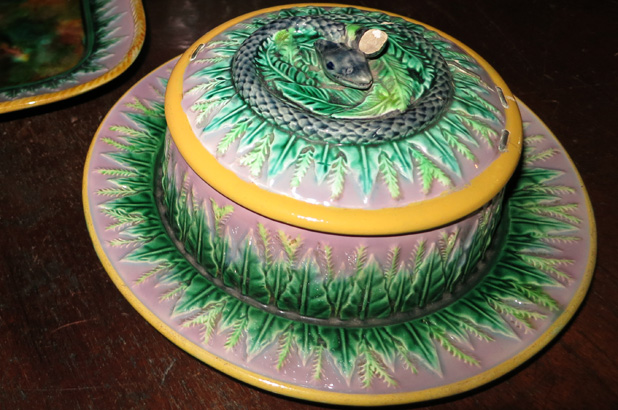In addition to their farmed produce, the Macarthurs had access to a variety of local delicacies. They employed a huntsman who, according to Elizabeth, furnished their table with wild ducks and kangaroos to the tune of 300lbs (135kg) per week! The Parramatta River, which marked the northern boundary of Elizabeth Farm, yielded fish, large mud oysters and, as Rugby League fans who follow the Parramatta Eels team will appreciate, a healthy stock of eels. In fact the name Parramatta is derived from the Darug word, Barramatta, meaning ‘place where the eels lie down’ (to breed in the river).
A refined dish
Eel was well regarded on 19th century tables, served in a variety of ways – boiled, fried, stewed, in soups and pies, and also, collared. It’s very likely that the Macarthurs included collared eel on their family table, as it was one of the dishes recommended to Anna-Maria Macarthur Mrs E’s advice on what to serve your guests. The art of collaring as a way of preparing foods seems to have faded from our culinary repertoire, with the exception of perhaps ‘collared beef’ which my local butcher still makes on request for a few of his elderly customers.
The lost art of collaring
Essentially, collaring is a process where suitable foods are rolled and bound with tape (or these days, string) to hold their shape. The concept remains today in a rolled roast, a French style roulade, Italian veal involtini and of course, roll-mops – Scandinavian fish fillets preserved in a salt and vinegar pickle (pickled herrings). The term ‘collared’ however seems to have been lost to history. Ideal for thin cuts of meat, fillets of fish and of course, eel, the flesh is seasoned with salt and spices then boiled and sometimes pickled, or breaded to create a layer of stuffing (think of our rolled shoulders of lamb) and then roasted, adding flavour and bulk to a secondary cut of meat. Small collared items would be served whole, larger cuts sliced to display their pin-wheel layers.
Collared Eel.
Bone a large eel, but don’t skin it: mix pepper, salt, mace, allspice, and a clove or two, in the finest powder, and rub over the whole inside; roll it tight, and bind with a course tape. Boil in salt and water till enough, then add vinegar, and when cold keep the collar in pickle. Serve it either whole or in slices. Chopped sage, parsley, and a little thyme, knotted marjoram, and savoury, mixed with the spices, greatly improve the taste.
(Maria Rundell, A new system of domestic cookery, John Murray, London, 1816, p17.)
Sources
Parramatta City Council: Indigenous History and Activities: http://www.parracity.nsw.gov.au/live/my_community/indigenous_history_and_activities
You can view the 1808 edition of Maria Rundell’s A new system of domestic cookery at http://books.google.com.au/books?id=K2YDAAAAQAAJ&pg=PP9#v=onepage&q&f=false
Note: The Parramatta Rugby League team is known as the Parramatta Eels



